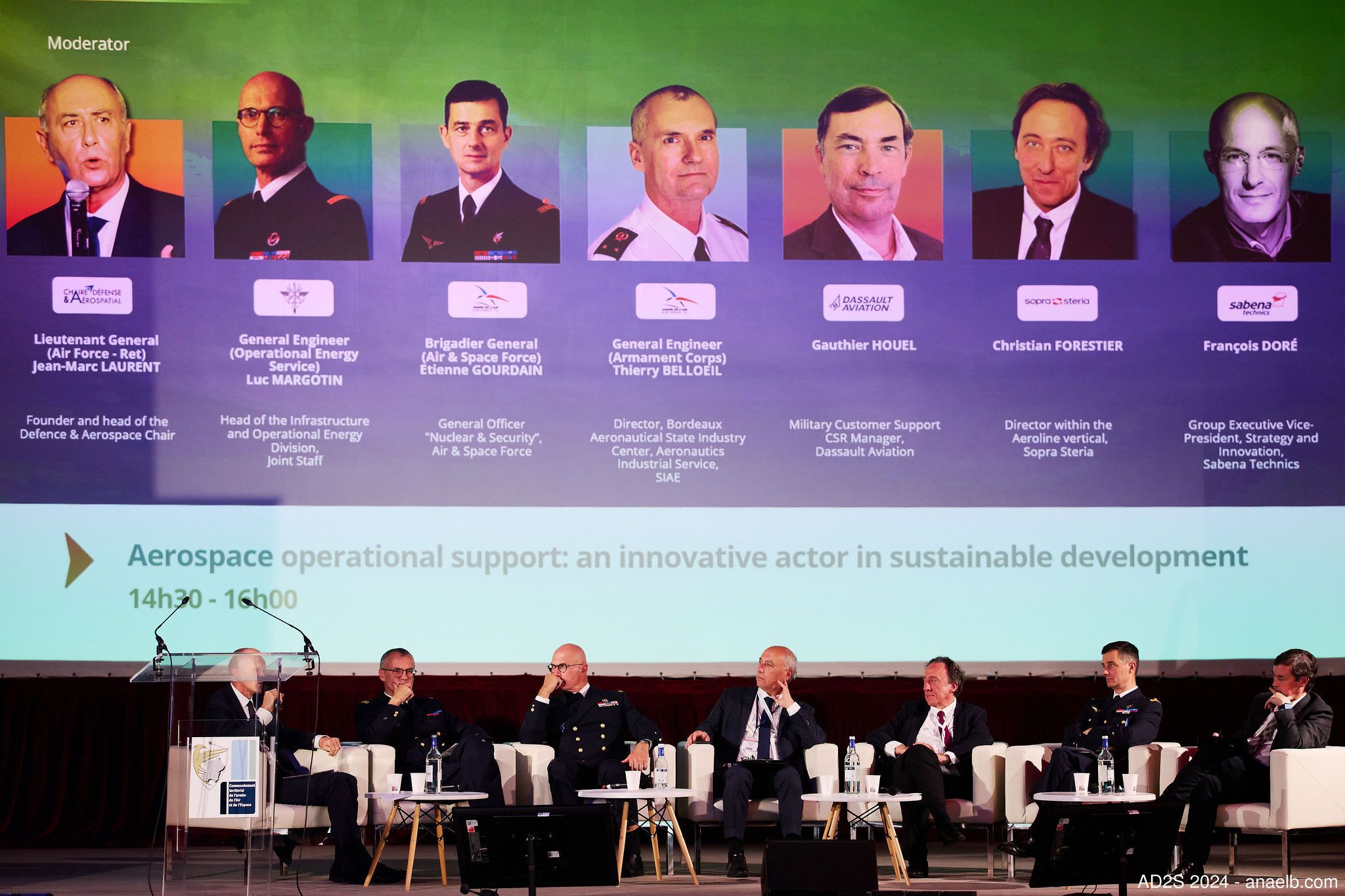
Towards a “Sustainable Defense”: Balancing Operational Efficiency and Environmental Imperatives (Part I)
March 5th, 2025 – By Murielle Delaporte
Highlights from the fourth panel of the AD2S conference cycle, titled “ The Aerospace Operational Support Services: An Innovative Actor in Sustainable Development”
Moderated by Lieutenant General (2S) Jean-Marc Laurent, founder and head of the Defense & Aerospace Chair at Sciences Po Bordeaux, the panel featured the following speakers:
- Engineer General Luc Margotin, head of the Infrastructure and Operational Energy Division, French Armed Forces
- Armament engineer Thierry Bellœil, director of the Industrial Aeronautics state facility (AIA) in Bordeaux, SIAé
- Air Force Brigadier General Étienne Gourdain, General Officer for Nuclear and Security, Air and Space Force Staff
- Gauthier Houel, CSR Manager, General Management of Military Support (DGSM), Dassault Aviation
- Christian Forestier, Director, Vertical Aeroline, Sopra Steria
- François Doré, Deputy General Manager for Strategy and Innovation, Sabena Technics
The panel sought to explore how environmental conservation and sustainable development can remain national priorities without compromising the operational effectiveness of the armed forces—not only during peacetime and competitive phases, but also during full-scale, high-intensity engagements.
“The logic of confrontation and environmental standards should not be in opposition; on the contrary, they should strive to converge,” emphasized General (2S) Laurent in his introduction.
The panelists agreed with this premise, acknowledging its feasibility in many cases while also recognizing significant obstacles to widespread adoption across the military MRO sector.
The discussion among public and private military MRO stakeholders focused on four main themes:
- Environmental impact on the armed forces
- Energy efficiency
- Resource conservation
- Anticipating innovation in military MRO for sustainable development
1. Environmental Impact on the Armed Forces
Representing the French Air and Space Force (AAE for “Armée de l’Air et de l’Espace”), General Gourdain addressed the connection between military MRO and sustainable development from the standpoint of resilience and climate-related challenges emerging on air bases. “The Air and Space Force operates from its air bases,” he stated, emphasizing the need to maintain their effectiveness as “combat tools” in the face of increasing natural disasters such as floods and wildfires—like happened recently at Cazaux Air Base.
This need for resilience is heightened by the AAE’s growing role in responding to crises and providing disaster relief. For example, the versatility of the MRTT tanker aircraft allows it to quickly reconfigure and assist in managing crises directly caused by climate change, which the Chief of staff of the French armed forces has referred to as a “catalyst for chaos.” The armed forces must be prepared for such events.
The AAE’s commitment to sustainable development also influences recruitment and retention. “Young people are very aware of these issues, so it's only natural that our operations—especially at our air bases—should minimize environmental impact.”
While operational priorities remain paramount, there are clear opportunities for alignment. General Gourdain cited the replacement of the Alphajet with the PC21 turboprop trainer as a win-win: it reduced the carbon footprint while improving operational readiness, particularly in systems management training for the Rafale.
However, some trade-offs remain unresolved, such as the use of PFAS (fluorinated chemicals) in firefighting foam. Although these chemicals pose environmental risks - especially groundwater contamination -, there are currently no effective alternatives for training purposes.
2. Energy Efficiency
Engineer General Luc Margotin, head of the Infrastructure and Operational Energy Division with the Joint chief of staff, emphasized the need to ensure the armed forces have the energy required for training and operations, including potential high-intensity conflicts.
The military’s energy requirements vary not only by type—land, naval, and aeronautical fuels, as well as electricity—but also by location (homeland vs. operational theaters). As operations become increasingly digital and connected, electricity demand on the battlefield is also surging[1].
Christian Forestier of Sopra Steria noted that digital activities now account for 3–6% of global carbon emissions—comparable to the aviation sector.
Despite these challenges, the general staff of the armed forces is leveraging sustainable development to enhance operational efficiency. IGA Margotin highlighted equipment hybridization as a key opportunity, citing three main benefits: reduced carbon emissions, access to alternative energy sources, and improved living conditions.
Since 2020, the armed forces have followed a defense energy strategy that includes targets for Sustainable Aviation Fuel (SAF). By 2025, biofuel content in aviation fuel is expected to reach 2%, with early acquisition efforts launched in 2022.
Domestic biorefinery development not only supports decarbonization, but also strengthens France’s energy independence—vital for ensuring military autonomy. This includes alternative fuels, lubricants, and hydraulic fluids like bio-oil, which are both greener and more efficient.
In the aeronautics sector, IGA Margotin emphasized rapid progress in certifying aircraft for SAF use. For example, in 2023, an NH90 helicopter successfully flew with 84% SAF. Further tests are planned starting in 2025 for helicopters and fighter jets, aiming for full qualification by the military. Transport aircraft follow civil certification via ASTM standards, which may allow 100% SAF engines by 2026, with widespread use projected by 2030.
Although it’s still early to draw definitive conclusions for the entire military MRO sector, results are encouraging: “Using biofuels reduces soot emissions, leading to cleaner turbines and injection systems, better combustion, and a lower infrared signature—a clear advantage for stealth,” said Margotin.
On the industrial side, companies like Dassault Aviation are also implementing energy-efficiency plans. Gauthier Houel explained their three-pronged approach: reduce energy consumption, generate renewable energy onsite, and manage/recycle waste—especially in new facilities.
Houel also highlighted the potential of electrification, both operationally and environmentally. Electrified systems offer flexibility, can be recharged in various ways (including with standard generators), and produce significantly less CO₂.
Note:
[1] A study is currently underway within the DGA (acquisition office) to assess the evolving energy needs of future battlefields.
Photo © anelb.com, 202
 English (United Kingdom)
English (United Kingdom)  Français (France)
Français (France)